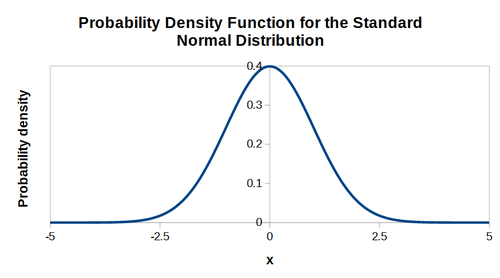Documentation/Calc Functions/PHI
TDF LibreOffice Document Liberation Project Community Blogs Weblate Nextcloud Redmine Ask LibreOffice Donate
Function name:
PHI
Category:
Statistical Analysis
Summary:
Calculates values from the probability density function of the standard normal distribution.
The normal distribution is also known as the Gaussian distribution. It is a family of continuous probability distributions used in many fields to represent independent, randomly generated variables. The standard normal distribution is the normal distribution that has a mean of 0 and a standard deviation of 1.
The lowercase Greek letter φ (Phi) is sometimes used to describe the probability density function of the standard normal distribution.
Syntax:
PHI(Number)
Returns:
Returns a non-negative real number, which is the value of the probability density function from the standard normal distribution for the given argument. The value returned is less than or equal to [math]\displaystyle{ \frac{1}{\sqrt{2\pi}} }[/math].
Arguments:
Number is a real number, or a reference to a cell containing that number, which is the value at which the probability density function of the standard normal distribution is to be evaluated.
- If Number is non-numeric, then PHI reports a #VALUE! error.
Additional details:
- Calc provides three related functions for calculating values from the standard normal distribution:
- NORM.S.DIST. Calculates a value from either the probability density function or the cumulative distribution function, depending on the setting of the Cumulative argument. Provided for interoperability with Microsoft Excel.
- NORMSDIST. Calculates a value from the cumulative distribution function, in accordance with the LEGACY.NORMSDIST function of ODF 1.2.
- PHI. Calculates a value from the probability density function, in accordance with the PHI function of ODF 1.2.
- For the standard normal distribution, the following relationships exist between relevant Calc functions:
- [math]\displaystyle{ \text{NORM.DIST}(x;\:0;\:1;\:0)\:=\:\text{NORM.S.DIST}(x;\:0)\:=\:\text{PHI}(x) }[/math]
- The formula for the probability density function of the standard normal distribution is:
- [math]\displaystyle{ PDF_{std\_normal}(x)~=~\frac{1}{\sqrt{2\pi}}~\text{EXP} \left(-\frac{1}{2} x^2 \right) }[/math]
- The following figure shows the probability density function for the standard normal distribution.

- For more information on the standard normal distribution, visit Wikipedia's Standard normal distribution page.
Examples:
| Formula | Description | Returns |
|---|---|---|
| =PHI(A1) where cell A1 contains the number 0. | Here the function calculates the probability density function of the standard normal distribution for the value 0. This is the maximum value of the probability density function. | 0.398942280401433 |
| =PHI(0.5) | Here the function calculates the probability density function of the standard normal distribution for the value 0.5. Since the standard normal distribution is symmetric about its mean of 0, the formula =PHI(-0.5) returns the same value. | 0.3520653267643 |
Related LibreOffice functions:
ODF standard:
Related (or similar) Excel functions:
PHI since v.2013.